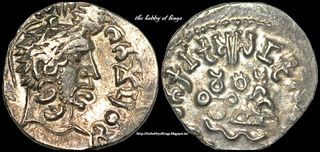Gautamiputra Satakarni

| Successor | Vasishthiputra Pulumavi |
| Mother | Gautami Sri-Bala |
| Predecessor | Sivasvati |
| Date of rise | 1st - 2nd century C.E. |
Gautamiputra Satakarni was an emperor & a great military commander of the Satavahana Dynasty in the present-day Deccan region of India, during whose rule the Satavahanas reached the greatest extent of their empire. He consolidated his rule within a few years of his accession and resolved to free the country of foreign domination of Western Kshatrapas. Although we’re uncertain about the exact dates of his accession to the throne, evidence suggests that he ruled in the 1st-2nd century CE.
The best known sources that throw light on his reign are the Nashik Cave inscriptions of his mother Gautami Sri-Bala and his son Pulumavi. An interesting epithet given to him in his Nasik inscription is ekabamhansa which is interpreted either as ‘the only Brahmana’ or as ‘the only protector of Brahmanas’.[ref] Other sources carrying on the legacy of the empire include numismatics, art, & the Puranas.
Military Conquests
Gautamiputra Satakarni is said to have extended the boundary of the Satavahana Empire across the length & breadth of the country. His kingdom stretched from the southern part of Rajputana, Kathiawad & Malwa in the north to the Krishna in the south, and from the Arabian Sea in the West to the Bay of Bengal in the east. It is said that he defeated the Sakas, Yavanas & the Pahlavas.
After ascending the throne, he first invaded Vidarbha & occupied its chief city Kusavati (modern-day Pauni) on the Vainganga River. He then took up arms against the Western Kshatrapa ruler Nahapana & defeated him in an aggressive battle in the vicinity of Govardhana near Nashik. To commemorate this victory, Gautamiputra soon visited the Buddhist caves near Nasik & donated a field to Buddhist sangha over there. The date assigned to the battle of Govardhana on the basis of unearthed evidence is around 125 C.E. This was followed by another war within a fortnight where Gautamiputra went after Nahapana again & completely exterminated him and his family in another battle fought near Karle in the Poona district. He has been described as ‘the exterminator of the whole Kshaharata family’ in a Nashik cave inscription of Pulumavi. Afterward, he visited the Buddhist caves at Karle & donated the village of Karajaka to the Buddhist sangha there. Numismatic evidence from Jogaltembi in the Nasik District also suggests that he re-struck a large number of Nahapana’s coins with his own symbol, celebrating his victory.
These splendid victories boosted the morale of the emperor and he embarked on a digvijaya, and soon conquered several countries. A Nashik cave inscription mentions a list of countries under his rule in North as well as South India. This includes Saurashtra (Kathiawad), Kukura (south-east Rajasthan), Akaravanti (Eastern & western Malwa), Anupa (modern Indore and Nemad districts of Madhya Pradesh), Aparanta (North Konkan), Rishika, Asmaka (Ahmadnagar district), Mulaka & Vidarbha. His kingdom encompassed the mountains ranges of Vindhya, Rikshavat, Mount abu, Krishnagiri, Manchagiri, Sristana, Malaya, Eastern ghat, Svetagiri & Chakora. The Nashik Prashasti further states that his horses are said to have drank the water of three oceans in the course of his digvijaya. However, historians are of the view that there may be some exaggeration in this description.[ref]
Nashik Cave Inscription
The Nashik Prashastis are a significant source of information on the glorious ruler Gautamiputra Satakarni. It not only enlightens us about his numerous military victories but also about his personal appearance, character & conduct. One such inscription was incised by his mother Gautami Sri-Bala in Nashik Cave III, which was popularly known as Devi-lena (the Queen’s Cave). This inscription is unique in ancient records & gives us a character sketch of the great emperor. From this epigraphic study, we get an impression that Gautami Sri-Bala exercised immense prestige & influence on her son.
The inscription tells us that the Gautamiputra Satakarni was as righteous as he was brave. He levied reasonable taxes on his subjects & was called eka-Brahmana because he implicitly followed the rules of his own caste. It states that the king abhorred violence & used to forgive even those who offended him. It also mentions that he had great reverence for his mother & was engaged in serving her. After a careful analysis of these writings, we can conclude that these accounts are of eulogizing nature, considering the person who patronized them was the ruler’s own mother. Nevertheless, it does not dilute the significance attached to this source in the study of the Satavahana Empire.
Death
The time & reason of Gautamiputra’s death cannot be ascertained with any clarity in the light of available sources. He was succeeded by his eldest son Vasishthiputra Pulumavi, who was also brave like his father but seemed to have lost certain provinces captured by his father. However, it was only during his reign that the eastern Deccan became a part of the Satavahana kingdom.
